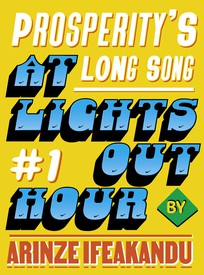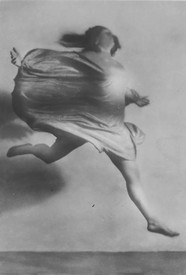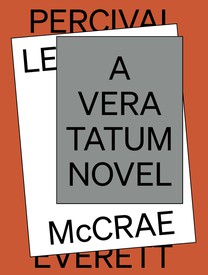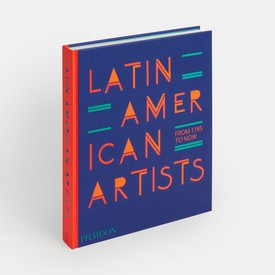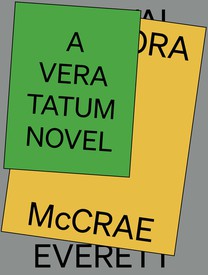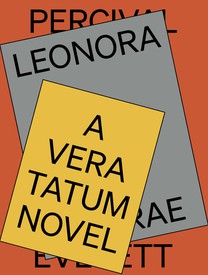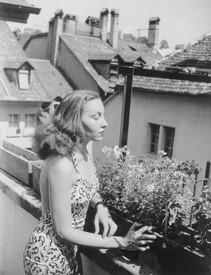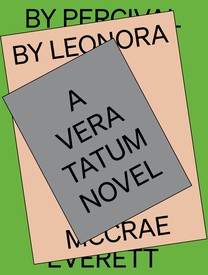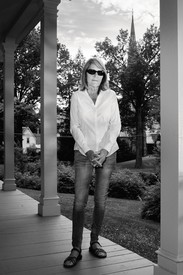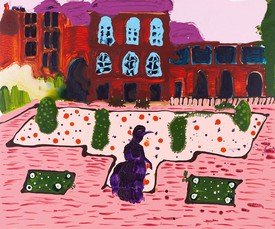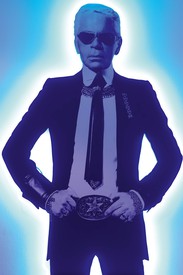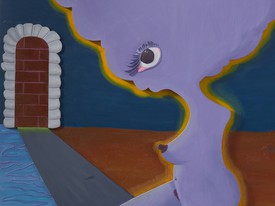
Francine Prose’s most recent novel is The Vixen (2022). Other books include Caravaggio: Painter of Miracles, Peggy Guggenheim: The Shock of the Modern, Reading Like a Writer, and Lovers at the Chameleon Club, Paris 1932. The recipient of numerous grants and awards, she writes frequently about art. She is a distinguished writer in residence at Bard College.
Hollis has never been able to explain why, of all the children she has been sent to photograph, she should have chosen Nadja. Maybe it was simply because there were so many children, and each one seemed to be asking a question to which Hollis answered No no no no. Maybe she just got tired of saying no and, on an impulse, said yes. She’d reached that point: worn down by how little she could do. The Foundation helped with the adoption, helped gladly, because of its long and successful association with Hollis. It made things easy, walking her through the interviews and advising her on how to complete the government forms.
Hollis is one of those still photographers and documentarians whose work has been proven to move people, to brings tears to eyes, lumps to throats, to touch the human heart in a very particular place that inspires donors to be generous—a miracle at a time when there is so much competition for charitable donations. Consequently, these filmmakers and photographers are very much in demand. If she wanted, Hollis could work constantly, which she tries not to do, because of Nadja.
The videographers film children being pulled from bombed-out wreckage; they move in for close-ups of newly freed hostages and refugees, uniformed soldiers weeping in the arms of their loved ones. Sometimes Hollis imagines that her employers count (electronically or optically) the benefit-dinner attendees with visible tears in their eyes, then plot that information against the size and number of donations and decide whether or not to rehire her based on the results.
Hollis takes photos of orphans. She likes the pictures she takes. The children don’t look like puppies, as they so often do on the TV ads for kids in need, their faces heartbreakingly hard to tell from those of the puppies pleading—silently, like the kids, with their eyes—to be rescued from shelters. At least there are no toll-free numbers to call on the pictures she takes. She lets the kids show their real selves. She finds ways for them to keep from having their personalities, their souls, reduced to their lack of parents. She’s making art, or something close enough to it for her to feel there was a point to all those hard years of apprenticeship, art school and whatever. She earns a decent living, not a fortune but enough to hire people she trusts to take care of Nadja when she’s away. Best of all, and unlike some of her artist friends, she never has to ask herself if what she is doing is useful. Not just useful, but good. She carefully vets the organizations for which she works. She wants to know if the money is going to the kids or to the private jet in which the CEO flies to pose with the orphans.
The Foundation raises millions. It sends medical supplies and food, and has even started little schools for refugees in camps in Sicily and Greece. Hollis’s artist friends consider her one of them. No one thinks she’s sold out. What with her work and raising Nadja, they tell her she’s a saint.
During the adoption, the Foundation suggested a complete medical workup, which Hollis agreed to, even though she had already made up her mind from the minute she’d seen Nadja sitting by an orphanage window, looking out on the winter rain and the cold gray Bucharest street. Hollis had thought, A girl in a fairy tale. Not any fairy tale but a particular fairy tale, though she couldn’t remember which one. She still doesn’t know. Maybe it was an illustration she’d seen as a child, maybe something she’d dreamed.
She took Nadja’s picture, which she used for the visa and the papers. Nadja has dark hair and eyes so improbably blue that they look, Hollis remembers thinking, like artificial food coloring. She was—and is—small for her age and terribly slight.
She has never learned to read. She doesn’t seem to care. At first Hollis tried to teach her, and then Nadja’s teachers did, but Nadja would sweetly shake her head no, and that was that. She can bathe and dress herself and cook simple dishes. And sometimes not so simple. Once, only once, she watched Hollis make egg salad, and now she can make it just like that. Egg salad’s her favorite food. She doesn’t seem proud of what she can do. It’s just what she does.
Nadja can spend hours by the window looking across the street at the park. The real miracle here is rent control, because though Hollis still makes a good living, the costs of raising Nadja—tutors, caregivers, a lawsuit to get her into the public school, transportation, programs and therapies, none of which changed anything—Hollis needs the money she earns.
Hollis has tried all sorts of things. After reading a book by a man whose child was drawn out of his shell by the magic of Walt Disney, Hollis bought several DVDs of feature-length cartoons, but Nadja fell asleep, always when the princess—the secret princess—was singing. Hollis tried a letter board, a ouija board, various simple computers, but of course Nadja can’t spell.
Hollis hasn’t given up on trying to give her daughter more life skills, better social skills. But it’s begun to occur to her that this is who Nadja is. This is who she is going to be. Now Hollis tries to approach each new attempt to break through without hope and without frustration. To begin and end with acceptance.
Still, sometimes she wonders: How could Nadja not be unhappy? Is she really content, sitting alone and motionless for hours? Like a Buddhist nun. Sometimes, secretly, Hollis sees Nadja as her teacher, but she would never say that to another human being. At the Foundation dinners, she’s heard speakers say that about children they met only once.
In four years, three young women have taken care of Nadja. They stay over when Hollis is gone and bring Nadja back and forth from school. They’ve all seemed to enjoy the job. Hollis pays well, Nadja’s sweet, and Hollis’s Upper West Side apartment, where she’s lived for twenty years, is way bigger than theirs. They quit only when they get other jobs (the work for which they’ve been studying) and move to different cities. The job has been passed down from one helper to the other, which is why all four have been Columbia graduate students.
Along the way, Hollis lost two men—first her husband, Rich, and then Frank, the serious boyfriend—because they weren’t on board about Nadja. Neither was saying send her back to Romania or even put her in treatment. But neither could hide their belief that Hollis was a naive sentimental woman who’d gone a little crazy when her biological clock stopped ticking.
Both told her that she’d known better—that she must have known what was going to happen when she took on a child like Nadja. They’d lost her at “a child like Nadja.” There was no other child like Nadja. The thought of what might have happened to Nadja without her intervention is, for Hollis, as sad and confusing as imagining her own death. Thinking about Nadja growing older in government care, Hollis half-enjoys what the Chinese call tongue-in-sore-tooth pain. That’s why it didn’t work out with the two men, both of whom she loved. She even loved daily life with them, which is harder and rarer than love for a person. But finally it became impossible to live with someone who didn’t understand about her daughter. Being alone seemed less lonely.
Her current helper, Sigrid, is a very smart, very nice, very young woman from Denmark who is writing her doctoral thesis on Scandinavian science fiction from the 1950s.
It’s getting harder to pack a carry-on and fly to Quito or Lima. Travel is losing its appeal. Maybe it’s just inertia, because when Hollis finally leaves, she is often glad to be someplace else and engaged by what she’s doing. On the road she’s in constant communication, by text and phone, with Sigrid, and she talks to Nadja—Sigrid holds the phone up to Nadja’s ear. Nadja says nothing. Hollis hears her breathing. That sound is her voice, in which Hollis recognizes her daughter’s hello.
Now the Foundation has “adopted” an orphanage on the Sicilian island of Lampedusa, and it asks Hollis to go photograph the children.
She has an overnight in Palermo. How intensely she longs to stay there and cancel the rest of her trip is her first real indication that something has changed. If only she could stroll around, eat offal sandwiches from carts, and photograph the writhing statues, marbled with car exhaust. But she’s a professional, still. She lugs her equipment onto a boat, then onto another boat.
Most of the children are Syrian, terrified and shell-shocked. Many are sick. At night, in her hotel, she can’t stop hearing them cough. The children seem drugged, they don’t even flinch when the shutter blinks.
Someone has to take these pictures. To show someone what’s happening here. To try to get someone to help. But not Hollis. Not anymore. Take this cup from me. With Nadja she went from no to yes, and now, as abruptly, she’s going from yes to no. This is going to be her last job of this sort. She will find something else. She can’t look at their poor sad faces. She’s agreed to do this, but afterward it’s over.
She talks to the kids, she tries to talk, but the kids aren’t talking. She has learned a few magic tricks, pulling quarters out of their ears and so forth, but the kids don’t laugh, they don’t even register surprise. They’ve had some surprises. Big ones. A coin in their ear seems like nothing.
She edits the images half-heartedly. She emails the least upsetting ones—that is, the ones that have the least power to upset her.
Of course the Foundation adores the Lampedusa photos. They say it’s her best work yet, and when (backing down already) she says that she’s thinking of taking a break, the woman who heads the Foundation says, Let’s take a break from thinking about taking a break, and they need to have a conversation about negotiating her salary upward. Hollis can’t remember feeling this uncertain about things that, only a short time ago, she took for granted. Until now she’s always gone from less certain to more.
Three plane flights after leaving Lampedusa, Hollis gets back to New York at four on an autumn Saturday afternoon. The city has that weekend feel, and the haze and mist have so weakened the sunlight that it no longer has the strength to warm. You want to be cozy, you want to be home inside with your family, problems and all.
Sigrid is at the kitchen table, reading. Hollis finds Nadja where she so often is, sitting by the living room window.
Hollis kisses Nadja’s forehead, Nadja lets herself be kissed. Nadja’s skin smells like the lavender soap she loves. A previous helper, Ivy, introduced them to the soothing qualities of lavender.
Sigrid asks how her trip was and Hollis says tiring but fine. She asks Sigrid what she’s reading: a Norwegian dystopian novel that got its author into trouble because it seemed to refer to things that happened during the Second World War.
“Interesting,” says Hollis. If someone forced her at gunpoint to repeat what Sigrid just said, she couldn’t. “How’s Nadja?” They spoke yesterday from the Rome airport, but now that Hollis is home, they can say things that might seem less important but are possibly more revealing.
Normally, when Hollis comes home, Sigrid sticks around long enough to talk about Nadja. Sometimes she asks if Hollis wants something to eat, if she can make her a sandwich, if she needs anything else, and then she goes back to her apartment.
This time, Sigrid says, “Can I show you something?”
She takes Hollis into Nadja’s room, with its unique, dear scent of lavender and egg salad. Sigrid takes a folder from a bookshelf, the same shelf where the ouija board and Disney DVDs and interactive picture books that haven’t worked are gathering dust.
In the folders are a half dozen sheets of white typing paper. On each sheet is a drawing done with colored pencil. Each is very elaborate, in a style that can’t be categorized as one thing or another. Boldness of anime, simplicity of folk art, stylized grace of Aubrey Beardsley.
In one image a gray wolf is spread out flat, as if he’s been skinned and made into a rug, or crucified. Turned to one side, his toothy mouth hangs open. Inside his body, unmoored, tumbling, as if in outer space or drowning, are a girl in a red cape with a hood and an old woman in a white nightgown.
“Little Red Riding Hood,” Hollis says.
“You got it,” says Sigrid.
In the next drawing, a mountainous woman in a tight green-and-red-striped gown holds up her foot, contemplating, with horror, a tiny transparent slipper dangling off her big toe.
“Cinderella,” Hollis says.
“Bingo again,” says Sigrid.
In the third, a dead woman, streaked with blood, lies slumped in one corner of a white room, while on the other side of the room a beautiful, frightened young woman is talking to a giant black crow in a cage. The women in the drawing look like no one Hollis knows.
“I’m not . . . ”
“The Robber Bridegroom,” says Sigrid.
“Grimms’ fairy tales,” says Hollis.
“Right again,” says Sigrid.
“Did you read them to her?”
“Never,” says Sigrid. “I assumed you did. She went to the bookcase and got the book without even looking at it, and took it to her room and did these.”
“Maybe one of the others,” says Hollis. “I mean, the other helpers. Maybe one of them read the stories to her.”
“No doubt,” Sigrid says.
Hollis still has the others’ email addresses and she emails each of them. The header says: Strange Question. The text: Hi! Did any of you ever read or tell Nadja Grimms’ fairy tales? Snow White? Cinderella? It’s not a problem if you did, just curious, XOXO Hollis.
They had been chosen for being the kind of people who answer emails right away, and within a few hours all of them have sent back responses ranging from I’m sure not, to No, to I’m pretty sure not, to Maybe Hansel and Gretel.
The next day, jet-lagged from the journey, Hollis wakes up at five. Nadja’s light is on, though ordinarily she sleeps late. Alarmed, Hollis goes into Nadja’s room. She’s sitting at her desk. A piece of paper is in front of her, the plastic tub of colored pencils by her right hand. She is drawing with that hand, while with the other she holds a volume of Grimms’ fairy tales up to the side of her head, pressed against her ear, as if it’s a phone on which she’s listening to someone speak.
A girl in a fairy tale, Hollis thought once. Only now does she understand that she wasn’t thinking about her past or about Nadja’s present, but about the future they’d share together. About this moment that finally seems to have come.
Is Nadja hearing the stories in the book? She’s not looking at the pages. The book is closed. She seems to be receiving some sort of transmission.
Hollis wants to see Nadja do the drawings, she wants to see it herself. In the back of her mind she had wondered if Sigrid was playing a trick on her, or maybe it was Nadja, or Sigrid and Nadja together. Maybe Sigrid found the drawings and pretended Nadja did them. But why would Sigrid—why would anyone?—do that?
Nadja’s hand moves across the page, then back and across the page again, in a funny sweeping motion, right to left and left to right, more like windshield wipers than a hand drawing. Gradually the drawing appears. A little boy sitting on the ground beneath . . . a gallows. Where would Nadja have seen a gallows? How would she know that such a thing existed?
Her hand glides across the paper, pauses. She puts the pencil back in the box, then carefully and deliberately chooses another color. Afraid to disturb her, Hollis hangs back, but she can’t help herself and inches closer. Nadja gives no sign of being aware of her presence. She draws a girl tenderly holding a frog. A man and a woman contemplating a fish that is larger than either of them.
Hollis leaves the room. She hears the toilet flush, several times, but no other sound. It’s all she can do to keep herself from going to check. Nadja goes to the kitchen, makes herself some egg salad, pours a glass of milk, eats. Then she returns to her room.
When Hollis goes in there at the end of the day, three more drawings are spread out across the table: A donkey vomiting gold coins. A man playing a violin. Seven black birds—ravens, maybe, or crows.
Hollis wonders what to do. Should she show them to people? Tell her friends? Nadja’s work may not be what’s happening in the art world right now, but given who Nadja is, and what she seems to be doing, it’s a story. There’s no doubt about that. And someone will want to tell it.
Hollis can imagine Nadja on 60 Minutes. Miracle orphan artist girl. Maybe Nadja’s drawings will sell, and Hollis won’t have to work anymore, or at least they will buy her some time to decide what she wants to do besides take pictures of orphans. Hollis doesn’t want to think this, but once she does—well, there it is.
At the same time, she thinks she should keep this a secret, tell no one, spare Nadja the unwanted attention and the inevitable misunderstanding that will come along with the strangers who will want to know—and want the world to know—what she does and how she does it. Maybe Hollis doesn’t want to know, doesn’t want the mystery explained. She likes being reminded of how much she will never understand. She knew that when she chose Nadja. But from time to time—for long stretches of time—she forgets.
She’s staring at a picture of the Grimms’ golden fish. The wishes that are granted are always the wrong ones. The worst ones.
She’s startled when Nadja takes—no, seizes—the other edge of the paper. Nadja looks at her mother, her bright blue eyes shining. Otherwise her face is as blank as the sheets of paper on which she has not yet made a mark.
Nadja looks at the drawing, then at Hollis. Her lips are moving, as if for speech.
“Mine,” Nadja says, and looks away. She has said all she has to say.
“The Lives of the Artists II: Prodigy” by Francine Prose. Copyright © 2018 by Francine Prose. All rights reserved.
Read “The Lives of the Artists I: The Master of the Prophetic Clouds,” “The Lives of the Artists III: Muse X Two,” “The Lives of the Artists IV: Rock Baby”
